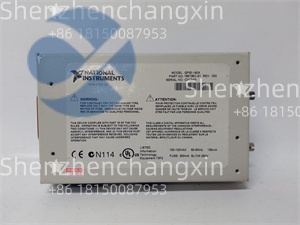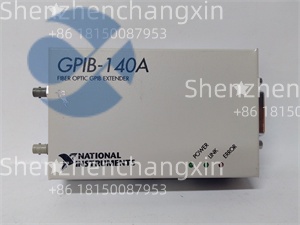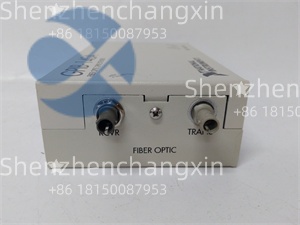Introduction
In semiconductor testing,efficient and reliable data transmission and real-time diagnostics are critical to ensuring test accuracy.The NI GPIB-140A fiber-optic GPIB extender,a high-performance device,provides an excellent solution for semiconductor test benches with its DMA transfer technology and LED diagnostics.This article will delve into the specific applications and advantages of these two technologies in semiconductor test.
NI GPIB-140A Device Overview
The NI GPIB-140A is a fiber-optic GPIB extender from National Instruments(NI)designed for test environments requiring long-distance,high-bandwidth GPIB communication.Using fiber-optic connectivity,it offers higher bandwidth and interference immunity than traditional cable connections,extending GPIB system transmission distances up to 1 km while maintaining GPIB signal integrity.
Key technical features include:
High-speed transmission:Supports high-speed data transmission,enabling fast instrument control and data acquisition.
Fiber-optic connection:Provides higher bandwidth and improved interference immunity.
Low latency:Fiber-optic transmission offers very low latency,enabling real-time control and responsiveness.
Stability:Suitable for long-term stable operation and demanding applications.
Scalability:Increases the maximum number of GPIB devices in a system from 15 to 26.
Application of DMA Transfer Technology in Semiconductor Testing
DMA Technology Principles
Direct memory access(DMA)is a data transfer mechanism that allows peripherals to directly read and write system memory without CPU intervention.In semiconductor testing,DMA technology can significantly improve data transfer efficiency and reduce CPU utilization.
DMA workflow includes:
Initial configuration:The CPU sets DMA parameters(source address,destination address,transfer length,and transfer mode).
DMA transfer initiated.
Data transfer:The DMA controller directly accesses memory/peripherals.
Transfer completion:The bus is released,an interrupt is triggered,or a status flag is updated.
Implementation in the NI GPIB-140A
The NI GPIB-140A uses DMA technology to achieve efficient data transfer,making it particularly suitable for semiconductor testing scenarios that require processing large amounts of data.Compared to traditional CPU transfer methods,DMA transfer offers the following advantages:
Features:Traditional CPU transfer FPGA DMA transfer
CPU utilization:100%(polling/interrupt)0%
Latency:100-1000 clock cycles 2-10 clock cycles
Parallelism:Single-threaded sequential transfer Multi-channel concurrent transfer
In actual semiconductor testing,DMA technology ensures fast and accurate test data transmission,avoiding test errors caused by CPU processing delays.
LED Diagnostic Function Details
LED Diagnostic Technology Principles
The LED diagnostic function uses LED indicators to display device operating status and fault information in real time.In semiconductor testing,this intuitive diagnostic method helps engineers quickly identify and locate problems.
LED diagnostics typically monitor the following parameters:
Photoelectric and electrical properties:luminous flux,luminous efficacy,spectral characteristics,etc.
Electrical and thermal properties:forward voltage,current,power,etc.
Reliability testing:lifespan assessment,switching durability,etc.
Implementation in the NI GPIB-140A
The NI GPIB-140A integrates advanced LED diagnostics,enabling real-time device status monitoring and providing intuitive fault indication.Specific implementations include:
Status indicator:Displays device operating status using different colors and flashing patterns
Fault code:Specific flashing patterns correspond to specific fault types
Self-test function:Automatically performs an LED self-test at device startup to ensure the diagnostic system is functioning properly.
This diagnostic method greatly simplifies troubleshooting and improves semiconductor test bench maintenance efficiency.
Real-World Application Examples in Semiconductor Test Benches
Test Bench Architecture Design
In a typical semiconductor test bench,the NI GPIB-140A typically serves as the core communication device,connecting the test instruments and the host computer.Its architectural design features include:
Long-distance connection:Utilizes fiber optic technology to enable long-distance connections between test instruments and a host computer.
Multi-device support:Connects up to 26 GPIB devices to meet complex testing requirements.
Signal isolation:Provides electrical isolation to protect devices from interference and damage.
Practical Application Benefits
The NI GPIB-140A has achieved significant advantages in semiconductor testing:
Improved test efficiency:DMA technology ensures fast data transfer,shortening test cycles.
Enhanced system stability:LED diagnostics monitor device status in real time to prevent failures.
Simplified system integration:The standard GPIB interface is compatible with a variety of test instruments,reducing integration challenges.
Expanded test capabilities:Supports connecting more test devices to meet complex testing requirements.
Industry reviews and expert recommendations
Industry experts highly praise the NI GPIB-140A for its use in semiconductor testing:
High performance:DMA transfer technology significantly improves data transfer efficiency,making it suitable for demanding test environments.
Reliability:LED diagnostics enhance system maintainability and stability.
Flexibility:The standard GPIB interface and fiber optic expansion capabilities make it suitable for a variety of test scenarios.
Expert recommendations for using the NI GPIB-140A in semiconductor testing include:
High performance:DMA transfer technology significantly improves data transfer efficiency,making it suitable for demanding test environments.
Reliability:The LED diagnostics enhance system maintainability and stability.
Flexibility:The standard GPIB interface and fiber optic expansion capabilities make it suitable for a variety of test scenarios.
Expert recommendations for using the NI When using the GPIB-140A,consider the following:
Plan your GPIB network topology appropriately to avoid signal degradation.
Regularly check the LED diagnostic status to prevent potential failures.
Leverage DMA technology to optimize test procedures.
Keep device firmware updated to receive the latest feature improvements.
Conclusion
The NI GPIB-140A,with its innovative DMA transfer technology and LED diagnostics,provides an efficient and reliable solution for semiconductor test benches.DMA technology ensures high-speed transfer of test data,while LED diagnostics provide intuitive device status monitoring.The combination of these two technologies significantly improves semiconductor test efficiency and reliability,making it an indispensable component of modern semiconductor test systems.As semiconductor test requirements continue to evolve,the NI GPIB-140A and its related technologies will continue to play a vital role in driving test technology advancements.
选择深圳长欣,选择放心,售后无忧 大量现货,当天顺丰发货!!!
 WhatsApp:+86 18150087953 WeChat: +86 18150087953
WhatsApp:+86 18150087953 WeChat: +86 18150087953  Email:
Email:








